Bircle
The official parish of Bircle near Bury, UK was created on 1 July 1846 although the village pre-dates this by many centuries. It is believed that 'Bircle' is a shortening of the phrase 'Birch Hill' as it is suggested that birch trees are found in abundance. This is very plausible idea until one searches for birch trees and finds the majority of trees in the area are sycamore and ash even where the thickly wooded areas reach the borders of the parish.[1] Such names such as "Cleggs Wood" "Simpson Clough" and "Dobb Wood" appear on early Ordnance Survey maps. What adds confusion to the whole picture is that 'hill' does appear in the fourteenth century in the name of 'Birkhill' but it never found a permanent place. Over a period of time its name has also appeared as Brithull, 1243; Birlcil, 1246; Birkhill, 1334, 1573; but Bircle appears in the Diocese of Manchester directory in England.
| Bircle | |
|---|---|
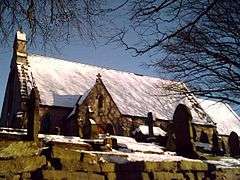 Bircle Church in Winter | |
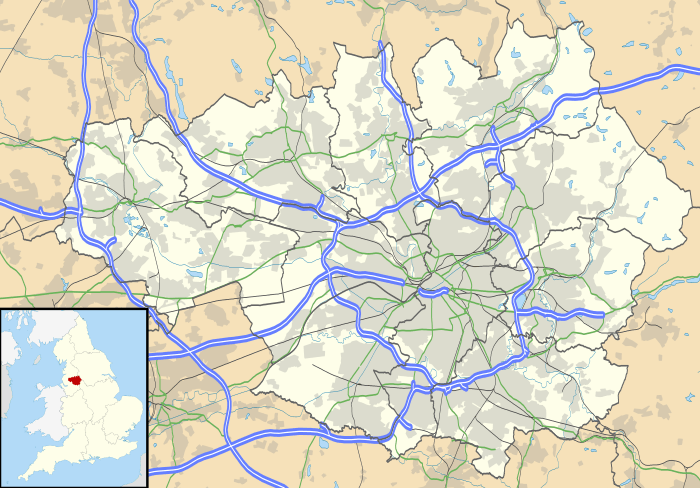 Bircle Location within Greater Manchester | |
| OS grid reference | SD829122 |
| Metropolitan county | |
| Region | |
| Country | England |
| Sovereign state | United Kingdom |
| Post town | BURY |
| Postcode district | BL9 |
| Dialling code | 0161 |
| Police | Greater Manchester |
| Fire | Greater Manchester |
| Ambulance | North West |
Bircle is a village in Greater Manchester. A name which is as ancient as the Domesday Book and certainly dating to many centuries before it became a Parish. Bircle church itself is on Castle Hill Road, Bircle, Bury, Greater Manchester.[2]
Parish
Vicars of the parish
- Thomas Wilson 1846–1891
- Charles Renshaw 1891–1920
- R P Trend-Smith 1920–1935
- J W Maddison 1936–1957
- R H Pickering 1958–1962
- Arthur J Dobb 1962–1972
- David Harrison 1972–1983
- Marcus Maxwell 1984–1993
- Arthur Ross Brockbank 1993–2012
- Gordon Joyce 2012–2019
- Harvie Nicol 2019-
The church
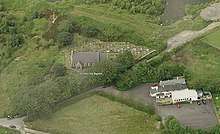
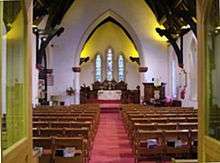
The church of St John the Baptist,[3] also known as Bircle Church, is a listed building for its special architectural or historic interest.[4] The church was designed by architect George Shaw and was first dedicated in 1846. It is a small church and is a relatively early example of ecclesiologically correct gothic rock-faced ashlar with ashlar dressings and slate roofs with stone-coped gables. The nave and chancel both have hammer beam roofs rising from stone corbels. Carved angels holding shields are on the ends of the hammer beams. There are four stained glass windows in the nave. These were given in memory of loved ones. They depict Ruth, St Peter, St Paul and Mary, the mother of Jesus. On the wooded ceiling are carved angel figures. Long:-2.260 Lat:53.607
Church hall
The Mural in Bircle Parish Hall. The old church hall had a mural across the whole of one side of the wall by local artist and potter, Harry Johnson, in the 1960s, this is perhaps his largest piece of work! It depicts the resurrection scene by the Sea of Galilee. Sadly the church hall is no more. The church hall used to be halfway down Castle Hill Road where the Sunday school and other community events took place. It was sold off by the church to make way for housing.
Kirk Rock
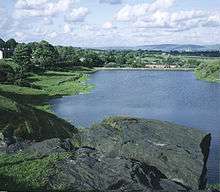
It is believed from accounts in the Journals of the Methodist minister, John Wesley, that on Friday 26 July 1778 and Thursday, 6 April 1780 that he preached on Kirk Rock to the people of the area. In the background you can see Bircle Mill which was later named Wills Fabrics
Boaredge Barn
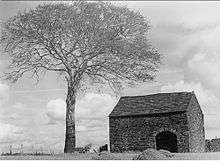
Boaredge barn is the oldest building in Bircle dating back to 1560 on the top of Gallows Hill. Next to the barn is the old hangman's tree. The barn itself is very unusual in that there is an opening on both sides so that the carts could go in one side and drop the hay off and carry on out of the other side of the barn.
The Workhouse
In 1852 plans were made for a workhouse to accommodate 400 inmates, with a separate 60-bed hospital in Jericho. Jericho workhouse, also known as the Bury Union Workhouse, was opened on 21 January 1857, and a year later the total expenditure for the scheme had swollen to £20,481.[5] Inmates came from as far away as Spain. In the 1881 census a 64-year-old named Susannah Allport, a Bonnet Maker (Milliner) from Salamanca was in residence.
Today it is the site of Fairfield General Hospital.
Historical timeline of Bury Workhouse
The Road to Jericho[6]
1775- A workhouse was built on Manchester Road, Redvales, Bury.
1825 - Bury Select Vestry recommended that the town needed to build a new workhouse or improve the existing one.
1827 - The Vestry decided to extend the existing Bury workhouse.
1837 - The Poor Law Union was formally declared on 8 February
1850 - The Bury Board of Guardians were refused an extension on the lease of land for the workhouses
1852 - The Bury Board of Guardians gave notice that they were prepared to receive plans and specifications for a new Union workhouse capable of support 400 inmates with suitable outbuildings, yards and conveniences.
1853 - The Vaccination Act introduced compulsory vaccination against smallpox. It required that every child, health permitting should be vaccinated within 3 months, or in the case of orphans, 4 months of birth.
1855 - Work began on the new Bury Union workhouse at Jericho, almost two miles east of Bury on Rochdale Old Road.
1857 - The Bury Union workhouse opened on 21 January. The total cost of building and land was £21,418.
1858 - The Bury Union workhouse was consecrated by the Bishop of Manchester on 26 July
1862 - Additions were made to the Bury Union workhouse providing separate infant accommodation.
1867 - The poor law guardians were to control vaccination districts and pay vaccinator from 1 - 3 shillings per child vaccinated in the district.
1868 - Additions were made to the Bury Union Workhouse to provide separate accommodation for the 'insane'.
1877 - On 9 June the foundation stone for a new 32 bed infectious diseases hospital at Jericho site was made by Alderman John Duckworth, chairman of the Bury Board of Guardians. There was also to be a nurses' home and mortuary.
1878 - The infectious diseases unit was opened on 24 August
1903-1905 - A new 126 bed infirmary with a maternity ward and staff accommodation was erected on the Jericho site. The site was officially opened on 20 September 1905.
1904 - The Registrar General requested that the workhouse births were to be disguised by the use of postal addresses. Birth certificates for those born in the Bury Union workhouse gave the address 380 Rochdale Old Road, Bury and did not name the workhouse.
1911 - Bury Union workhouse added an annexe to house male inmates.
1929 - Bury Union workhouse was renamed Jericho Institution.
1946 - The last burial took place at the Jericho Institution cemetery.
1948 - The Jericho Institution became part of the NHS and was renamed Fairfield General Hospital.
Cheesden Valley
The Cheesden Valley runs on a north-south alignment between Bury and Rochdale. Cheesden Brook runs through the valley, joining with Naden Brook to eventually run into the River Roch near Heywood. During the industrial age the valley became a centre of cotton production dependent on running water. The valley is now slowly but surely reclaiming the once busy mills and taking it back to nature. It encompasses Deeply Vale, Bircle Dene and Ashworth Valley.
Mining
As early as 1580, Queen Elizabeth I granted John Blackwall the right to mine coal in the Cheesden Valley. In addition, it is believed that during the 17th century small communities – ‘Folds' – could have had their own mines.
Mills
The first mill in the valley was probably erected at Kershaw Bridge in 1780 by Thomas Allanson. It was a fustian mill and may have used Arkwright water frames.
John Haworth's Four-Acre Mill was high on the moors above Cheesden and was powered by a waterwheel. Haworth, who diverted the waters of a tributary stream to turn his wheel, later built a huge lodge to provide a consistent head of water for himself and other millowners - until then, they had been at the whim of the weather, laying off workers during dry spells and calling them in at all hours when the valley flooded.
A John Kay (not to be confused with the John Kay who invented the flying shuttle) built Cheesden Valley's Lumb Mill in 1786, as a fulling mill, turning woollens into felted materials.
Cheesden Brook provided power for at least 15 mills and employment for 2,000 people. Communities grew up in what had once been a desolate region.
These moorland mills held their own for more than half a century against their big-town rivals, many finding a niche for themselves, as mainline competition increased, by developing as cotton-waste spinners. This involved recycling the inner core of yarn cops, which had been stiffened in manufacture by the application of starch paste to avoid the need for separate wooden bobbins. During the cotton famine caused by the American Civil War these waste mills actually experienced a boom.
By the 1870s the mills were struggling to compete against the steam-powered economics of their massive rivals in the nearby towns and, before the turn of the century, they had all but vanished. Many of the former mills, lodges and a solitary chimney, along with other industrial workings such as Weirs and Dykes, are still evident today for those who know where to look. Today all that can be found are the ghosts of what was once a thriving community.
• Four Acre • Cheesden Pasture (app. b. 1810) • Lower Pasture • Cheesden Bar • Cheesden Lumb Upper • Cheesden Lumb Lower • Longlands • Croston Close Upper • Croston Close Lower • Deeply Hill • Deeply Vale • Washwheel • Bircle Dene • Kershaw Bridge
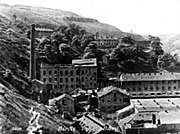 Bircle Dene Mill
Bircle Dene Mill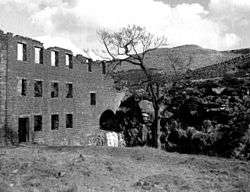 Cheesden Lumb Mill
Cheesden Lumb Mill
Bircle Dene
At the turn of the eighteenth century Bircle Dene was utilised for one of the first cotton mills in Lancashire. Walk along the Dene today and the ghosts of the mills that lined Bircle Dene are steadily being reclaimed by nature as they crumble away. Even today if you look with care the old pack horse trail can still be seen.
Owd Ned's Mill (Bircle Mill)
Bircle Mill is one of the earliest of the cotton factories at the birthplace of the Industrial Revolution. Originally it was called 'Owd Ned's Mill' but in its long career has possessed many other owners. In its early days it had connections with the Peel family - of Sir Robert Peel fame. Despite the changes and the near collapse of the cotton industry it was one of the few that kept going until its eventual demise under the name of 'Wills Fabrics' in 2004. The building can be seen in the distance from Kirk Rock.
 Owd Ned's Mill in Bircle Dene
Owd Ned's Mill in Bircle Dene
Pre-Industrial History
There are signs of human activity dating from about 8000 BC. Flints from the Mesolithic period have been found in the Cheesden Valley and Knowl Moor areas. All were discovered on high ground close to a water source, and all are quite small and suitable for use as arrowheads and similar objects.
References
Archives Plus
Archives+ has created an archive centre of excellence in the heart of Manchester. The project brings together statutory, university and voluntary organisations to provide a holistic range of archive and heritage services from one location. Archives+ raises awareness of and provides easy access to our histories for the broadest possible audiences.